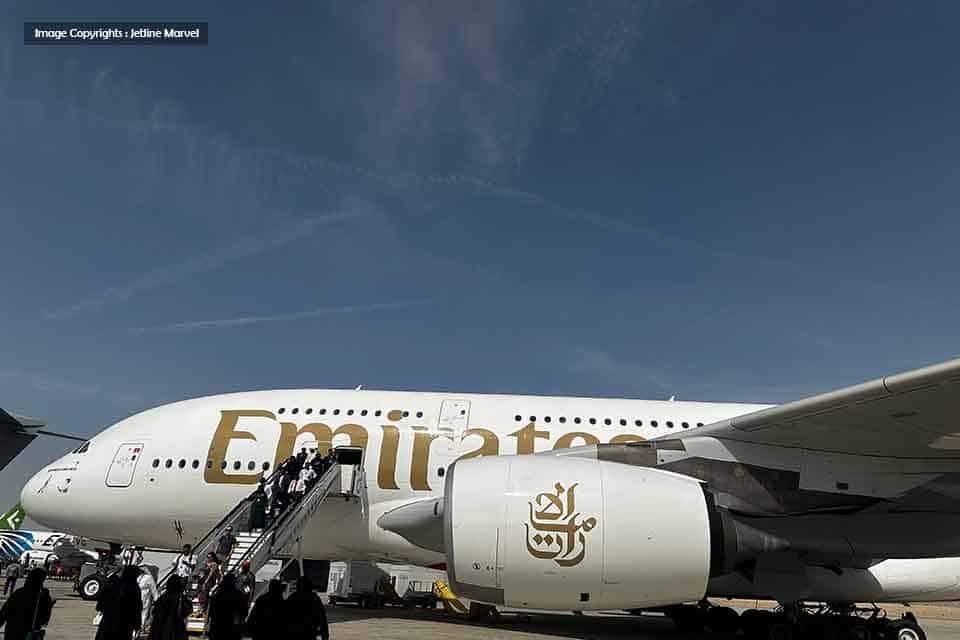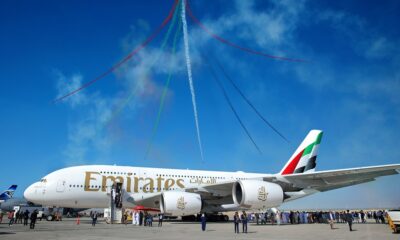Aviation
What exactly led to the big hole in the Emirates A380?

An Emirates A380-800 safely landed at Brisbane, Australia (??) with a huge hole in its fuselage. The mechanical issue that plagued Emirates’ scheduled trip from Dubai to Brisbane was only identified after the plane had landed in Brisbane, Australia.
Some passengers claim that 45 minutes into their flight, they heard a tremendous blast before learning that the jet had nearly finished the full 14-hour journey with a hole in its side.
A loose bolt smashes a sizable hole into the side of the jet, horrifying the terrified people on board Emirates flight, and an Australian passenger on board claims he could ‘feel’ the puncture in the floor.
A few of them were initially believed to be a tyre explosion, but it was subsequently discovered that the aircraft confronted a loose bolt that blew a huge hole in the side of the aircraft. One of the passengers reported feeling a hole in the floor.
Emirates Airbus A380 (A6-EVK) departed rwy 30L at Dubai (OMDB), VAE on flight #EK430 to Brisbane, Qld, Australia where it landed safely. After landing, a large hole was seen in the left fuselage, allegedly coming from a detached bolt in the nosegear.https://t.co/o1EqBuJ0bA pic.twitter.com/s4p6tIpXDw
— JACDEC (@JacdecNew) July 2, 2022
According to the source At 10.45 p.m. on Saturday, the A380 departed from Dubai and touched down at Brisbane International Airport. After takeoff, according to passengers, they heard an ominous noise but had no idea what was going on during the lengthy journey.
#Emirates, Airbus #A380 (A6-EVK) flight #EK430 has landed in #Brisbane with a hole in the side of aircraft after a wheel exploded during its take off from #Dubai, crew told to ATC during its approach to Brisbane.
? Avherald#Airbus #Australia #UAE #aviation #AvGeek #avgeeks pic.twitter.com/WjmKmde8wi
— FlightMode (@FlightModeblog) July 3, 2022
As it approached Brisbane, the crew informed ATC that Airbus A380 (A6-EVK) flight EK430 had landed with a hole in the side of the aircraft after departing Dubai with a wheel explosion.
About 13.5 hours after taking off, the plane landed on Brisbane’s runway 19R and was then pulled to the apron. Following the observation of a sizable hole in the left hand wing root fairing, penetration at the fuselage’s bottom was found.
In a local interview, a Brisbane airport employee said that the crew had informed them they suspected a blown tyre on departure and that emergency personnel were waiting for the landing.
The reason behind the loud blast.
Some reports state that shortly after the Emirates A380 took off from Dubai, a left side rear loose bolt blew a huge hole in the side of the aircraft. This resulted in the tyre blast. Additionally, the pilot kept going to their destination despite hearing an explosion. All of the systems appear to be functioning normally. However, they informed Brisbane ATC of the malfunctioning landing gear as they approached, landed safely, and arrived on schedule.
The plane will stay in Brisbane for inspection and maintenance. The wellbeing of our workers and passengers has always come first. Additionally, the investigation must determine the fault’s root causes.

Aviation
South Korea Introduces Cutting-Edge MRO Center for F-35 and IAI

South Korea is set to make waves in the aerospace industry with the establishment of a cutting-edge Maintenance, Repair, and Overhaul (MRO) hub for F-35 fighter jets and IAI (Israel Aerospace Industries) aircraft.
Central to this initiative is the specialization in converting Boeing 777-ERSF, colloquially known as the “Big Twin,” from passenger to freighter configurations. Under the terms of the agreement, IAI will spearhead the conversion of six B777-300ER and B777-200LR aircraft annually, commencing in 2024. This strategic move is in response to the anticipated surge in demand for wide-body freighter aircraft capable of long-haul flights.
Furthermore, South Korea’s forward-looking vision extends beyond aircraft conversion, with plans to establish a Lockheed Martin F-35 maintenance, repair, and overhaul depot at Cheongju Air Base by 2027. This strategic move not only enhances the operational readiness of South Korea’s air force but also positions the nation as a regional hub for F-35 maintenance expertise.
In preparation for this expansion, thirty Republic of Korea Air Force (ROKAF) engineers and technicians are slated to undergo intensive maintenance training in the United States in 2025, a testament to South Korea’s commitment to fostering local expertise and talent.
IAI’s visionary approach to certification and collaboration underscores the potential for transformative change. With plans for the 777-300ERSF certification process set to unfold in Israel, followed by the rigorous scrutiny of regulatory agencies such as the US Federal Aviation Administration (FAA), the stage is set for the ‘Big Twin’ to soar to new heights of success.
In partnership with esteemed entities like STK and Incheon International Airport Corporation, this collaboration promises to unleash a wave of benefits, amplifying the resilience and competitiveness of the Korean aviation sector while catalyzing job creation and economic prosperity.
Aviation
Lockheed Martin Expresses Interest in Joining AMCA Project

Lockheed Martin, a leading global aerospace and defense company, is demonstrating its dedication to strengthening collaborations with India’s research, industry, and academic sectors. With its rich experience in the aerospace industry and renowned for building some of the world’s most advanced jets, Lockheed Martin is now exploring opportunities to contribute to India’s aerospace sector, potentially providing a significant boost to aerospace technology in the country.
Randy Howard, Vice President of Global Pursuits at Lockheed Martin Aeronautics, recently underscored their interest in exploring “advanced transfer of technology opportunities” with Indian partners, signaling a proactive approach towards fostering technological exchange and advancement in the aerospace domain.
India has been at the forefront of fighter jet development since the 1970s, having produced its own cost-effective fighter jets and combat helicopters, while continually upgrading to maintain competitiveness on a global scale.
Lockheed Martin stands as a dominant force in the aircraft industry, renowned for developing cutting-edge planes like the F35 and F22, some of the most advanced fighter jets globally. They’ve also contributed to projects like the South Korean KF21 aircraft for defense purposes through collaborations.
Now, Lockheed Martin has set its sights on India’s defense sector manufacturing processes, expressing interest in partnering with India on its most anticipated project, the Advanced Medium Combat Aircraft (AMCA), likely to be a 5th generation fighter jet for the Indian military.
Their proposed collaboration could involve a spectrum of advanced technologies, including the Auto Ground Collision Avoidance System (Auto GCAS), a life-saving technology that intervenes to prevent ground collisions, thus significantly enhancing flight safety for Indian pilots.
Lockheed Martin is extending its expertise to design and develop an indigenous cockpit for the F-21 fighter jets, which India is procuring. This collaboration with Tata also includes the development of fighter jet wings. Established in 2023, this partnership adopts a “Ground Floor Design” strategy aimed at equipping India with an in-depth comprehension of 5th-generation cockpit technology and Man-Machine Interface (MMI) systems.
As India’s Fighter jet program advances with finalized aircraft frame and engine prototypes, Lockheed Martin has expressed interest in joining the project. They see a groundbreaking opportunity in cooperative 5th Generation Fighter Development, potentially expediting the AMCA program’s progress through technology and expertise sharing.
Furthermore, Lockheed Martin is keen on collaborating on large-wing, jet-powered UAV platforms, which could enhance India’s unmanned aerial capabilities.
While discussions are ongoing, and specific collaboration details await finalization, this initiative represents a potentially transformative stride in India’s aerospace self-reliance journey and Lockheed Martin’s strategic engagement with the Indian market.
Aviation
Can Airline Seat Cushions Be Used As Life Jackets?

In the event of an aircraft ditching into water, there’s a common question: Can aircraft seats serve as an alternative to life jackets for flotation? The answer lies in understanding their respective functions.
While seat cushions can provide some buoyancy in water, they are not intended nor certified to function as life jackets. Their primary purpose is to offer cushioning for passengers during flight. On the other hand, life jackets are meticulously engineered to keep individuals afloat in water, equipped with buoyancy materials, secure straps, and reflective elements for visibility. They offer numerous advantages over mere cushions.
While a seat cushion might offer temporary assistance in staying afloat, it’s not a dependable substitute for a proper life jacket during an emergency. It’s crucial to utilize approved safety equipment when near bodies of water. A life jacket, designed to keep a person buoyant for extended periods, offers the rigidity needed for prolonged flotation and allows for easy movement of the arms to navigate effectively.
What fabric is used in aircraft seats?
Seats are meticulously designed to fulfill multiple purposes, ensuring passenger comfort, safety, and protection from unforeseen circumstances like fires and accidents. A typical design incorporates an aluminum frame with blocks of polyurethane foam affixed to it. Additionally, a layer of fire-resistant fabric, such as Kevlar or Nomex, is often applied over this framework, topped with a layer of cloth or leather.
Leather seats, while luxurious, are more expensive compared to traditional cloth seats. The majority of fabrics used in seat upholstery contain at least 90% wool fiber, with the remainder typically consisting of polyamide (nylon). Wool stands out as the primary fiber chosen for commercial airline seating fabric due to its desirable properties and suitability for such applications.
What is the lightest economy seat?
In recent times, airlines have been downsizing seat dimensions to accommodate more passengers, resulting in reduced cushion length and leg space. This contrasts with earlier times when airlines offered more generously cushioned seats and ample amenities.
According to Recaro Seats Company, their SL3710 model represents the lightest economy class seat available, weighing in at a mere 8 kg (17.6 lb.), setting a new standard in aircraft seating.
For individuals weighing more than 350 pounds, fitting into a standard economy-class seat can be a challenge due to the narrower dimensions. Economy seats, also referred to as “coach,” “standard,” or “main cabin” seats, typically range from about 40 to 48 centimeters in width, further emphasizing the need for more accommodating seating options.



























